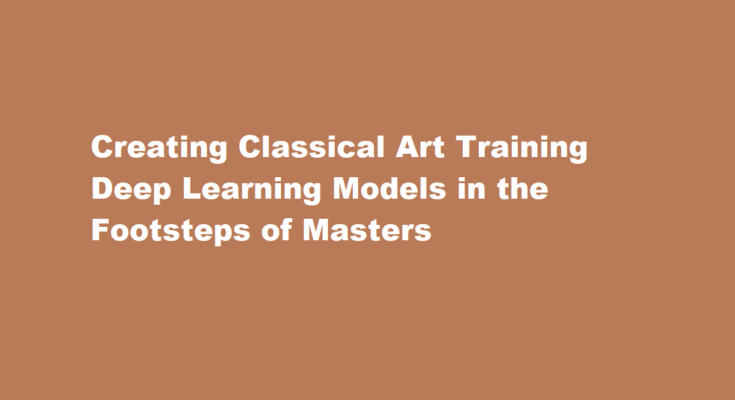Introduction
Art has always been a testament to human creativity and innovation. Classical art, with its rich history and unique styles, holds a special place in the world of creativity. Today, thanks to advances in deep learning and artificial intelligence, we have the opportunity to explore the boundaries of art by training models to generate original pieces in the style of famous artists. In this article, we will delve into the fascinating journey of training a deep learning model to create classical art.
Understanding the Task
Before we embark on this artistic journey, it is crucial to understand the scope of the task at hand. Generating original pieces of classical art in the style of a famous artist involves teaching a deep learning model to recognize and mimic the artist’s distinctive style, brushwork, color palette, and subject matter. This process requires a combination of art history knowledge, computer vision, and neural networks.
Data Collection
The foundation of any deep learning model is data. To teach our model to create art in the style of a famous artist, we need a comprehensive dataset of the artist’s work. Fortunately, many classical art pieces are in the public domain, making them readily accessible for this purpose. Gathering a diverse range of artwork by the chosen artist is essential to capture their unique style.
Preprocessing and Feature Extraction
Once we have collected a substantial dataset, we need to preprocess the images. This involves tasks like resizing, normalizing colors, and removing noise. Additionally, feature extraction techniques can be used to capture the artistic elements specific to the chosen artist’s style. This step is crucial for feeding meaningful information to the deep learning model.
Choosing the Right Architecture
Selecting an appropriate deep learning architecture is pivotal to the success of our art generation project. Convolutional Neural Networks (CNNs) are commonly used for image-related tasks. However, for generating classical art, we may need to employ more advanced architectures, such as Generative Adversarial Networks (GANs) or Variational Autoencoders (VAEs). These models excel at capturing intricate details and patterns in art.
Training the Model
Training a deep learning model for art generation is a resource-intensive process that requires a powerful computer or cloud infrastructure. During training, the model learns to replicate the style of the chosen artist by minimizing the difference between the generated art and the artist’s original works. This involves optimizing various parameters, including the learning rate, batch size, and architecture hyperparameters.
Fine-Tuning and Validation
After the initial training phase, it is essential to fine-tune the model to enhance the quality of generated art. Fine-tuning can involve adjusting model weights, optimizing loss functions, and incorporating additional artistic constraints to ensure the generated pieces align more closely with the artist’s style. Validation, using metrics like perceptual similarity, helps gauge the model’s progress.
Balancing Originality and Imitation
While the primary goal is to generate art in the style of a famous artist, it is equally important to inject a degree of originality into the creations. This balance between imitation and originality is where the true artistry of the project emerges. To achieve this, the model can be programmed to introduce subtle variations and deviations from the artist’s known works while preserving their core style.
Feedback and Iteration
Creating art with deep learning is an iterative process. Continuous feedback and evaluation are essential for improving the model’s performance. Art experts, artists, and enthusiasts can provide valuable insights into the generated pieces, helping refine the model’s ability to mimic the artist’s style more accurately.
Ethical Considerations
As we push the boundaries of art and technology, ethical considerations come into play. Ensuring that the generated art respects copyright and intellectual property rights is of utmost importance. Additionally, disclosing the artificial nature of the creations is essential to maintain transparency and authenticity.
FREQUENTLY ASKED QUESTIONS
How do AI art generators create original artwork?
These generators use machine learning algorithms and deep neural networks to generate new artwork based on a given input, such as a text description or an image. Modify existing art using AI: Another approach to creating art using AI is to modify existing artwork using AI tools.
What is deep art in deep learning?
Deep Art applies Deep Learning to artistic style [1], and is pretty good fun. A Convolution Neural Network (CNN) separates and recombines the content and style of an image, providing a neural algorithm for the creation of artistic images.
Conclusion
Training a deep learning model to generate original pieces of classical art in the style of a famous artist is a captivating fusion of art, science, and technology. This endeavor enables us to explore the depths of human creativity and the capabilities of artificial intelligence. As we continue to refine these models, we unlock new possibilities for artistic expression and appreciation, pushing the boundaries of what is possible in the world of classical art.
Read Also : Mastering The Art of Intricate Brain Surgery



